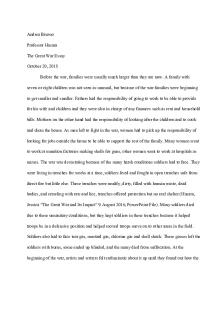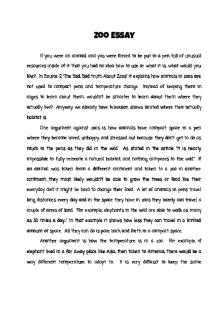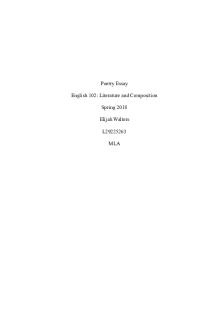The Great War Essay - Grade: B PDF

| Title | The Great War Essay - Grade: B |
|---|---|
| Author | Andrea Bisono |
| Course | Humanities - Twentieth Century |
| Institution | Valencia College |
| Pages | 4 |
| File Size | 49.9 KB |
| File Type | |
| Total Downloads | 79 |
| Total Views | 146 |
Summary
Essay on the great war...
Description
Andrea Bisono Professor Hasara The Great War Essay October 20, 2018 Before the war, families were usually much larger than they are now. A family with seven or eight children was not seen as unusual, but because of the war families were beginning to get smaller and smaller. Fathers had the responsibility of going to work to be able to provide for his wife and children and they were also in charge of any finances such as rent and household bills. Mothers on the other hand had the responsibility of looking after the children and to cook and clean the house. As men left to fight in the war, women had to pick up the responsibility of looking for jobs outside the home to be able to support the rest of the family. Many women went to work at munition factories making shells for guns, other women went to work at hospitals as nurses. The war was devastating because of the many harsh conditions soldiers had to face. They were living in trenches for weeks at a time, soldiers lived and fought in open trenches safe from direct fire but little else. These trenches were muddy, dirty, filled with human waste, dead bodies, and crawling with rats and lice, trenches offered protection but no real shelter (Hasara, Jessica “The Great War and Its Impact” 9 August 2016, PowerPoint File). Many soldiers died due to these unsanitary conditions, but they kept soldiers in these trenches because it helped troops be in a defensive position and helped moved troops move on to other areas in the field. Soldiers also had to face tear gas, mustard gas, chlorine gas and shell shock. These gasses left the soldiers with burns, some ended up blinded, and the many died from suffocation. At the beginning of the war, artists and writers felt enthusiastic about it up until they found out how the
soldiers were affected mentally, physically, and emotionally by the trenches they had to live in. By comparing the colors, lines, and tone of David’s “Napoleon Crossing the Alps” and Sargent’s “Gassed”, one can see the effects the Great War had on the arts. “Napoleon Crossing the Alps” was painted by a French artist named Jacques-Louis David in 1801. There are five different versions of this oil on canvas portrait of Napoleon Bonaparte on a horse leading the way by pointing ahead. This painting was associated with Neoclassicism. Neoclassicism is a formal, imperial style and imitation of Greek and Roman art. The goal of Neoclassical art was to have art with a moral focus or moral character. This art movement came along around the same time as the Enlightenment which was a movement to reform society though pure human intellect instead of relying on religion or faith to make life better. This painting relates to life before the war because everyone had this image of war being “A Jolly Little War” as the German crown prince predicted. There were crowds of women and children in France cheering on the soldiers as they left for the war, so this seemed like it was something to be enthusiastic about when it turned out to be the complete opposite. Areté is a term that means “excellence of any kind” or in other words it is the act of living up to one’s full potential, which is what David was trying to portray of Napoleon. Soldiers probably left to fight in the war expecting to reach their full potential fighting for their country. “Gassed” is an oil painting who was painted by an American artist named John Singer Sargent in 1919. This painting depicts the aftermath of a mustard gas attack during the war with soldiers walking in a line surrounded by dead bodies and a few soldiers suffering. This painting is associated with the Dadaist movement. The word Dada did not mean anything, just as life itself had come to seem meaningless after the war. (Hasara, Jessica “The Great War and Its
Impact” 9 August 2016, PowerPoint File). Dada art focused on the absurd and had many reactions to the war. The goal of Dadaism was to use irony, satire, and improvisation in art to shock the public into recognizing the contradictions of European culture. They wanted to stop the use of labels and create art that individuals would have to take a second look at. This relates to life after the war because hundreds and thousands of soldiers suffered from a damaged psyche after the war. They suffered from post-traumatic stress disorder, shell shock, and psychological trauma. In the painting, you can see how many dead bodies these soldiers are surrounded by. These are these soldiers’ friend’s, companions, they have been together for months in the trenches and to see they’re friends dead which causes a lot of pain and suffering. “Napoleon Crossing the Alps” features Napoleon dressed in gold, and riding a white horse, giving this painting a sense or feeling of leadership. The color gold associated with wealth, grandeur, wisdom, and courage. “Gassed” features a lot of dull colors such a gray, kind of a dirty brown, and the skyline is gray and foggy from the gas. You can also see sort of a blue tint around the soldiers who are on the floor. These colors give a feeling of sadness and grief. By just looking at the colors you can tell how things have changed after the war, it’s no longer about courage, these soldiers are going through serious issues and life or death situations. People feel like they have no motivation after the war, they had nothing left. Which brings me to another comparison of what life was like after the war. In “Napoleon Crossing the Alps” David uses many curvy lines moving to the right side of the painting creating a feeling of motivation in the piece. While on the other hand, In “Gassed” Sargent uses sharp lines, he could be trying to express how dreary the war felt, like it was never ending. The subject matter in “Napoleon Crossing the Alps” is Napoleon leading his army, looking like he knows what he’s getting into,
making him seem like a heroic character. In “Gassed” these soldiers seem exhausted, worn out, like they are just about ready to give up. Yet this painting does not portray them as heroic, which they should be. In conclusion, the Great War had a major impact on the arts. Artists and writers stopped trying to encourage others to go fight in the war with their work. Before the war, there was a huge spread of patriotism, motivation, and nationalism for people to go fight for their country. After the war, artists and writers started to portray the truth about the war and how badly soldiers got injured physically and mentally. Just by comparing how one feels when looking at these two paintings, one can only imagine how how life was before and after the war....
Similar Free PDFs

The Great War Essay - Grade: B
- 4 Pages

The Watchmen Essay - Grade: B
- 3 Pages

The mexican war - essay
- 2 Pages

Rogerian Essay - Grade: B
- 2 Pages

Zoo Essay - Grade: B+
- 2 Pages

Causation Essay - Grade: B
- 4 Pages

Final Essay - Grade: B+
- 12 Pages

Propaganda Essay - Grade: b
- 4 Pages

Poetry Essay - Grade: B
- 5 Pages

Galileo Essay - Grade: B+
- 6 Pages

Fiction Essay - Grade: B
- 7 Pages

EPQ Essay - Grade: B+
- 10 Pages

Law essay - Grade: B
- 9 Pages

Persuasive Essay - Grade: B
- 3 Pages

Evicted Essay - Grade: B+
- 3 Pages

Charities essay - Grade: B+
- 13 Pages
Popular Institutions
- Tinajero National High School - Annex
- Politeknik Caltex Riau
- Yokohama City University
- SGT University
- University of Al-Qadisiyah
- Divine Word College of Vigan
- Techniek College Rotterdam
- Universidade de Santiago
- Universiti Teknologi MARA Cawangan Johor Kampus Pasir Gudang
- Poltekkes Kemenkes Yogyakarta
- Baguio City National High School
- Colegio san marcos
- preparatoria uno
- Centro de Bachillerato Tecnológico Industrial y de Servicios No. 107
- Dalian Maritime University
- Quang Trung Secondary School
- Colegio Tecnológico en Informática
- Corporación Regional de Educación Superior
- Grupo CEDVA
- Dar Al Uloom University
- Centro de Estudios Preuniversitarios de la Universidad Nacional de Ingeniería
- 上智大学
- Aakash International School, Nuna Majara
- San Felipe Neri Catholic School
- Kang Chiao International School - New Taipei City
- Misamis Occidental National High School
- Institución Educativa Escuela Normal Juan Ladrilleros
- Kolehiyo ng Pantukan
- Batanes State College
- Instituto Continental
- Sekolah Menengah Kejuruan Kesehatan Kaltara (Tarakan)
- Colegio de La Inmaculada Concepcion - Cebu